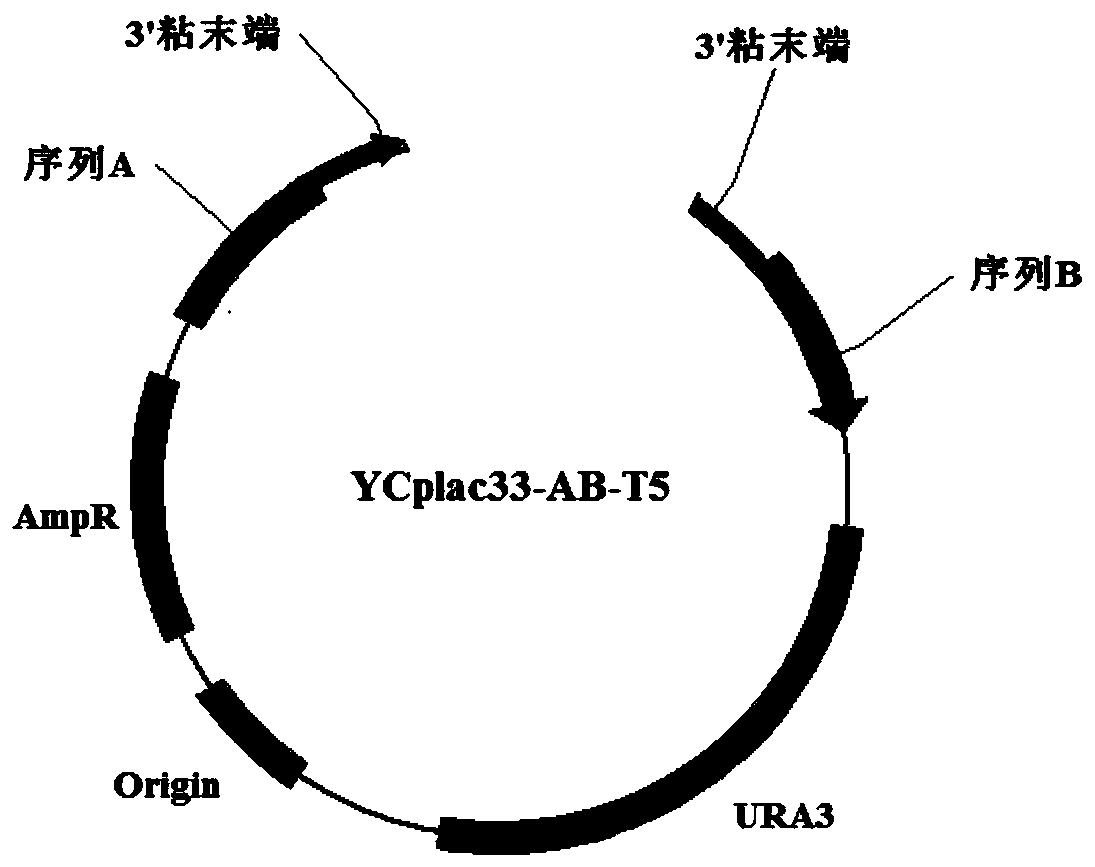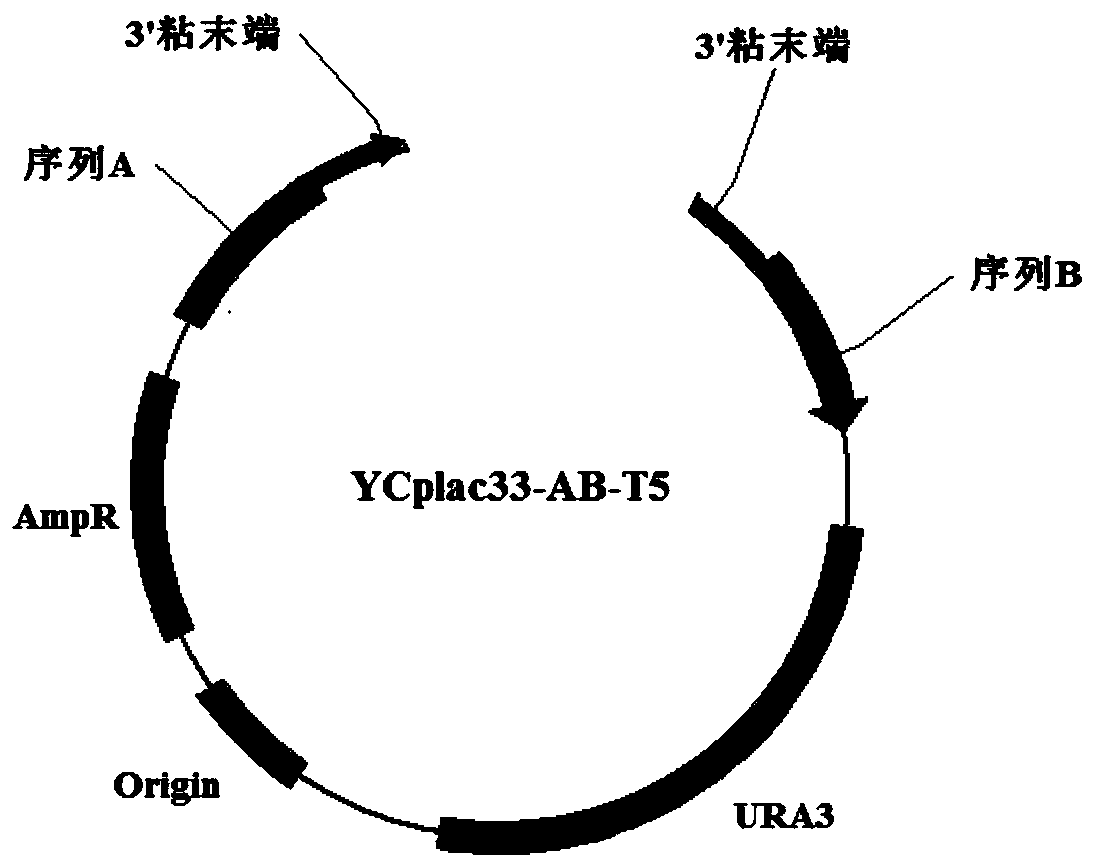Method for realizing high-accuracy gene homologous cloning in yeast
A high-accuracy, yeast-based technology, applied in the field of genetic engineering, achieves the effects of simple technical methods, high accuracy, and reduced labor
- Summary
- Abstract
- Description
- Claims
- Application Information
AI Technical Summary
Problems solved by technology
Method used
Image
Examples
Embodiment 1
[0027] Step 1: 1000 bp homologous sequence cloning of upstream (sequence A1) and downstream (sequence B1) of tor2 gene.
[0028] Cloning by polymerase chain reaction (PCR), the DNA polymerase used is the high-fidelity DNA polymerase (Phusion DNA Polymerase) produced by NEB, the amplification template is the genomic DNA of Saccharomyces cerevisiae gim2. Design and synthesize oligonucleotides, PPF1, PPR1, PTF1 and PTR1, the sequence information is as follows:
[0029] PPF1:5'-GACCATGATTACGCCAAGCTTGCAAGAAAGCGGAGGGAGAAGA-3'
[0030] PPR1:5'-GAAGATGCGGCCGCTGTTAC TTTTCATATGGGGAAAGTAA-3'
[0031] PTF1: 5'-GTAACAGCGGCCGCATCTTC TTTTAATGTATTGAAAATCA-3'
[0032] PTR1:5'-GACCTGCAGGCATGCAAGCTTGG CTCTTCCGCAATTCCAGCAG-3'
[0033] Primers PPF1 and PPR1 are used to clone the 1kb region upstream of tor2, and PTF1 and PTR1 are used to clone the 1kb region downstream of tor2. The PCR reaction system is as follows:
[0034] 5×HF reaction buffer (Mg 2+ Concentration is 7.5mM) 10μL, ddH 2 O 31...
Embodiment 2
[0058] Step 1: 100 bp homologous sequence cloning of upstream (sequence A2) and downstream (sequence B2) of tor2 gene.
[0059] The cloning method is the same as in Example 1, the primers are PPF2, PPR1, PTF1 and PTR2, and the sequence information is as follows:
[0060] PPF2: 5'-GACCATGATTACGCCAAGCTTGC AAAGGGAAAA TATACCGGGT-3'
[0061] PPR1:5'-GAAGATGCGGCCGCTGTTAC TTTTCATATGGGGAAAGTAA-3'
[0062] PTF1: 5'-GTAACAGCGGCCGCATCTTC TTTTAATGTATTGAAAATCA-3'
[0063] PTR2:5'-GACCTGCAGGCATGCAAGCTTGGGTAACGTCACGCTCGGAACT-3'
[0064] Primers PPF2 and PPR1 were used to clone the upstream 100bp region of tor2, and PTF1 and PTR2 were used to clone the downstream 100bp region of tor2. The PCR reaction system was the same as in Example 1 except that primer PPF2 replaced PPF1 and PPR2 replaced PPR1. The PCR amplification conditions were the same as in Example 1 except that the extension time was changed to 20 sec, and the PCR product purification method was the same as in Example 1.
[0065...
Embodiment 3
[0078] Step 1: 500 bp homologous sequence cloning of upstream (sequence A3) and downstream (sequence B3) of tor2 gene.
[0079] The cloning method is the same as in Example 1, the primers are PPF3, PPR1, PTF1 and PTR3, and the sequence information is as follows:
[0080] PPF3:5'-GACCATGATTACGCCAAGCTTGC TATATATTTA TTACCGTCAT-3'
[0081] PPR1:5'-GAAGATGCGGCCGCTGTTAC TTTTCATATGGGGAAAGTAA-3'
[0082] PTF1: 5'-GTAACAGCGGCCGCATCTTC TTTTAATGTATTGAAAATCA-3'
[0083] PTR3:5'-GACCTGCAGGCATGCAAGCTTGGCGGTAACAGGACAACAGCCA-3'
[0084] Primers PPF3 and PPR1 are used to clone the 500bp region upstream of tor2, and PTF1 and PTR3 are used to clone the 500bp region downstream of tor2. The PCR reaction system is the same as in Example 1 except that primer PPF3 replaces PPF1 and PPR3 replaces PPR1. The PCR amplification conditions were the same as in Example 1 except that the extension time was changed to 30 sec, and the PCR product purification method was the same as in Example 1.
[0085] St...
PUM
| Property | Measurement | Unit |
|---|---|---|
| diameter | aaaaa | aaaaa |
| length | aaaaa | aaaaa |
Abstract
Description
Claims
Application Information
 Login to View More
Login to View More - R&D
- Intellectual Property
- Life Sciences
- Materials
- Tech Scout
- Unparalleled Data Quality
- Higher Quality Content
- 60% Fewer Hallucinations
Browse by: Latest US Patents, China's latest patents, Technical Efficacy Thesaurus, Application Domain, Technology Topic, Popular Technical Reports.
© 2025 PatSnap. All rights reserved.Legal|Privacy policy|Modern Slavery Act Transparency Statement|Sitemap|About US| Contact US: help@patsnap.com


